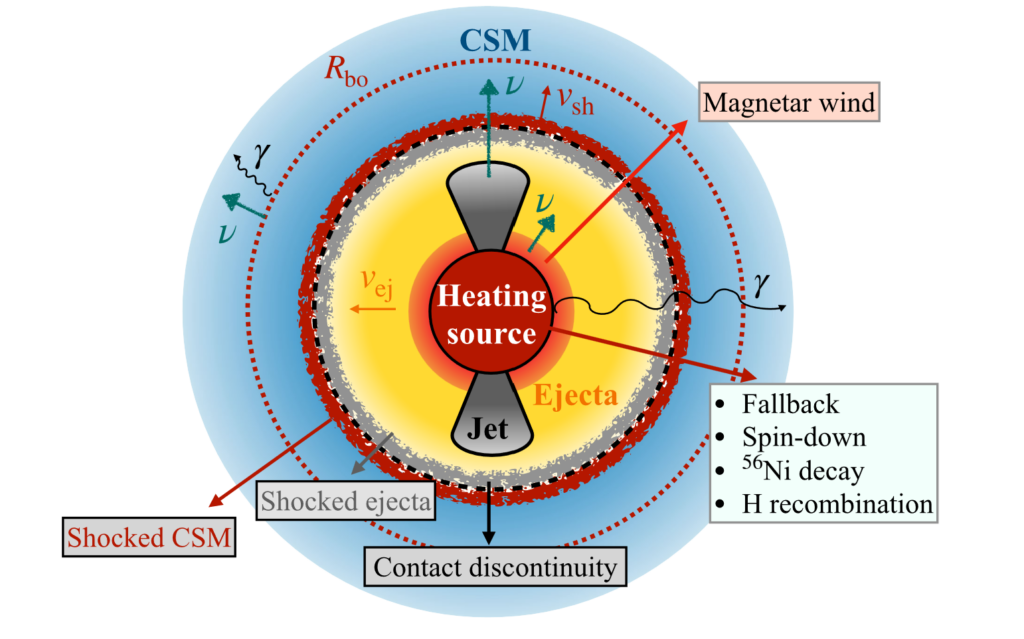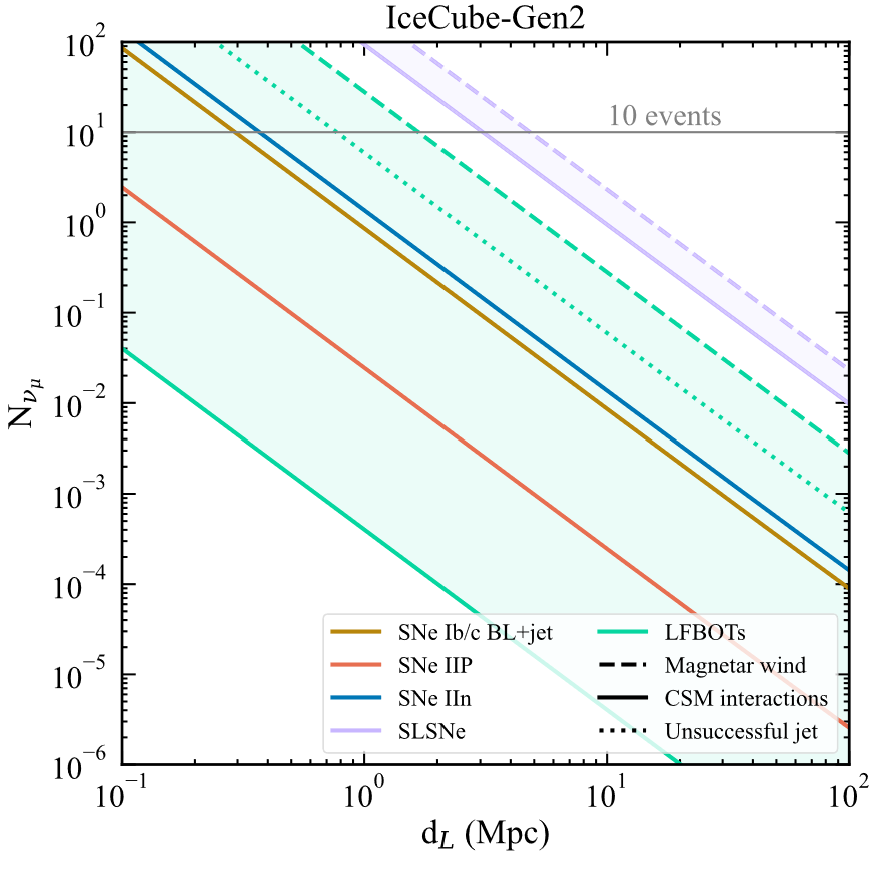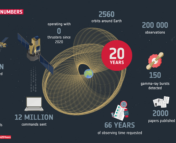Authors: Ersilia Guarini, Irene Tamborra, Raffaella Margutti, and Enrico Ramirez-Ruiz
First author institution: Niels Bohr International Academy & DARK, Niels Bohr Institute, University of Copenhagen, Blegdamsvej 17, 2100, Copenhagen, Denmark
Status: Published in PRD (closed access)
As stars collapse at the end stage of their lives, they give off spectacular fireworks displays. Collapsing stars are responsible for multiple different types of transients – including supernovae, gamma-ray bursts (GRBs), and maybe even luminous fast blue optical transients (LFBOTs).
But, these objects also give off more than just light – supernovae are one of a few known multi-messenger sources. In 1987, a supernova in the Large Magellanic Cloud, SN 1987A was observed across the electromagnetic spectrum, as well as in low-energy neutrinos. However, high-energy neutrino emission has not yet been observed from these sources.
Studying transients in both light and neutrinos can shed light on how collapsing stars produce their spectacular displays. Since we can’t observe a supernova up close, we play detective using the information we do have – from multiple messengers, light and neutrinos – to reconstruct what happened in the source.
Today’s authors aim to do just that, by modeling the expected emissions in multiple messengers in order to predict which observations will be most helpful for finding a source in both photons and neutrinos.
What can we see from collapsing stars?
When a star collapses, it provides a large amount of energy to the material around it, heating and accelerating that material. Let’s start by discussing what’s happening in the star when this happens (see the sketch in Figure 1).
As the star collapses, it becomes a heating source, which powers material to be ejected from the star (called “ejecta”). It may also produce relativistic jets (shown as grey cone-like structures) which may break out from the central area (“successful”) or fail to do so (“unsuccessful”). As the ejecta is accelerated, it produces shocks (grey and red circles), which interact with the material around the collapsing star (called circumstellar medium, CSM).

So, what can we see from Earth as this happens? The authors start by calculating an energy budget (amount of energy available to be radiated) in both photons and neutrinos. Depending on the supernova type and the interactions seen, we may see different signatures in photons and neutrinos.

A few examples of emissions we might see can be seen in Figure 2. In the case where there is a dense CSM around the star, we may see less high energy photons and more radio emission, but more neutrinos from the interactions with the CSM. If there is a jet, we would see emission throughout the electromagnetic spectrum for a successful jet – in the case of an unsuccessful jet, we would only see emission in X-rays and neutrinos, as the other photons cannot break out.
Photons and neutrino joint signatures
The authors consider several types of transients: Types 1b/c and 1b/c BL (broad line) with a jet, Type IIP and Type IIn supernovae, as well as superluminous supernovae (SL SNe) (for a summary of the different supernova types and what they mean, see this Guide). They also consider LFBOTs, a supernova-like class of transient, and although their source is still unknown, one of the proposed scenarios to explain them involves a collapsing star with a jet.
Neutrino emission is expected in 3 cases: (1) as a magnetar’s rotation slows down (spin down), as may happen in SL SNe and LFBOTs, (2) CSM interactions, as is the case in Type IIP or IIn supernovae or SL SNe or LFBOTs, or (3) in jets, as is the case for GRBs and possibly also LFBOTs.
In cases (1) and (3), we would expect to see an X-ray signature in addition to signatures in the UV/optical/infrared lightcurve. For the case of a magnetar, the authors’ model shows that we would expect to see very bright neutrino emission as the magnetar spins down. In the case of a jet, even if the jet is not successful we would still expect to see X-ray emission, as is shown in Figure 2.
In case (2), interactions with the CSM, the authors find that emission in the radio band is expected alongside neutrinos, and on the same timescales as the neutrino emission. Thus, the authors conclude that radio and X-ray emissions are essential to look for when searching for neutrinos from these sources.
Looking forward: detection prospects
To calculate how many neutrinos would be seen at Earth from these transients, the authors consider the IceCube-Gen2 detector, a planned expansion to the IceCube Neutrino Observatory. They calculate the number of high-energy neutrinos with energies above 100 TeV (that’s about ten times higher energy than the Large Hadron Collider!) expected from each considered transient type, as shown in Figure 3.
They find that SL SNe and LFBOTs are the most promising for neutrino emission, but these are also the rarest types nearby. Beamed emission (like in the case of GRBs) would also be promising, but we would have to be staring down the jet of the star to see these (and these jets are only a few degrees wide). Detecting these neutrinos is challenging, but would give us great new insights into these explosive sources!

Astrobite edited by: Sarah Bodansky
Featured image credit: edited from NASA, ESA, P. Challis, and R. Kirshner (Harvard-Smithsonian Center for Astrophysics), Public domain, via Wikimedia Commons and Knowledge at Dutch Wikipedia, CC BY-SA 3.0, via Wikimedia Commons





Thanks for the great read Jessie! Multi-messenger astronomy is so cool. I’m curious, why are there no low energy neutrino predictions in figure 2? Are the authors not concerned with low energy neutrinos because they’ve already been detected?
Hi, thanks for your question! You’re right that we would also expect low-energy neutrinos for these transients, but this paper is focused only on high energy neutrinos, which is why they don’t show predictions for low-energy neutrinos in the figure.